What is Chinese Sweet Pork Belly?
– caramelized pieces of pork, slow-cooked in a sweet and savoury broth until the liquid evaporates, leaving tender pork in a delicious sticky-sweet sauce.
Recipe Intro
Calling all pork enthusiasts! 🐷
Introducing a timeless favourite: Hong Shao Rou, or “red-cooked meat.” This iconic Chinese dish boasts a rich heritage and widespread popularity, revered for its tender, melt-in-your-mouth pork bathed in a sumptuous, sweet-savoury sauce.
While the basic concept of red-braised pork belly remains consistent across China, there are regional variations in ingredients and cooking methods. The Shanghai style of red-braised pork belly typically relies on soy sauce, sugar, and aromatics such as ginger and garlic for flavouring. In contrast, the more traditional Northern style often incorporates a wider array of spices, such as star anise, cinnamon, and cloves, resulting in a more complex, spicy and fragrant dish.
This dish is an authentic Shanghai-style red-braised pork with a twist. As a pork lover, I wanted to make it a substantial main meal by adding potatoes. So, while the recipe remains true to its roots, it now includes potatoes. The result is tender, succulent pork pieces and potato cubes enveloped in a delicious sweet, sticky sauce. It’s a complete meal that stands on its own, leaving you fully satisfied without the need for any additional accompaniments.
Essential Ingredients & Substitutes
- pork belly – This fatty and flavourful cut of pork is essential for creating succulent and tender pieces of meat. It’s important not to remove the skin, as its layers of skin, fat, and meat contribute to the rich texture and taste of each mouthful.
- brown sugar – This ingredient is crucial for adding sweetness and depth of flavour to the dish. Unlike white sugar, brown sugar brings a rich, caramelized taste that enhances the overall complexity of the dish.
- light soya sauce – Contributes a salty and savoury flavour to the dish
- dark soya sauce – Provides a rich colour and a slightly sweet, caramel-like flavour to the dish, enhancing its visual appeal and depth of taste.
- ginger – With its warm and aromatic flavour, ginger adds a zesty kick to the dish, balancing out the richness of the pork belly
- spring onion – It is used during the blanching process to infuse the pork belly with subtle onion flavour and aroma, enhancing its overall taste profile. Also used as a garnish when serving. If spring onions are unavailable, plain onion can be used as a substitute
- oil – Peanut oil is typically used for red-braised Chinese pork belly due to its high smoke point and neutral flavour, allowing for optimal caramelization of the meat. If peanut oil is unavailable, sunflower oil can serve as a suitable substitute, offering a similar high smoke point and mild taste to enhance the dish.
- Vegetables (optional): As mentioned earlier, I’ve added potatoes to make this dish a complete main meal. However, if you prefer the traditional version, it’s typically served with your favourite noodles or rice. If you enjoy this potato twist, consider adding carrots for an even richer variation.
How to make Chinese Sweet Pork Belly?
This dish involves three key stages: blanching the pork, caramelizing the pork, and slow-cooking it to perfection. Each stage plays a crucial role in developing the rich flavours and tender texture of the final dish.
First, cut the pork belly into small cubes.
Blanching pork belly
Fill a pot with cold water and add the pork pieces along with a few spring onions and sliced ginger. This sets the stage for the blanching process, allowing the flavours to meld together as the pork cooks. While cooking for 5 minutes, ensure you use a spoon to skim off any impurities and foam that rise to the surface.
Drain the pork pieces and pat them dry with a kitchen towel to remove excess moisture. This step is crucial as it minimizes splattering during the caramelization process. Save the cooking water (broth). You will need it for later.
Caramelising
Heat oil and sugar in a wok or large frying pan over low heat. Allow the sugar to melt slowly, stirring briefly. Once it turns amber and completely melts, carefully add the pork pieces and fry for a minute on high heat until golden brown.
Ensure you have all the other ingredients prepared and ready to add once the caramelizing process is complete.
Slow-cooking
Now, add 500ml of the blanching water in which the pork was previously cooked. Then, pour in the rice wine, light and dark soy sauce, finely chopped ginger, and garlic. Cook the mixture over low to medium heat with the lid, but do not cover completely, allowing the liquid to gradually evaporate. Add more broth as needed during cooking. After one hour, remove the lid and continue cooking for about 15-30 min, until most of the liquid has evaporated, resulting in a thick, sweet sauce. The pork should be tender enough to fall apart easily when pressed with a wooden spoon.
If you’d like to include potato cubes or even carrot pieces, add the vegetables after 30 minutes of cooking. Adjust the liquid level by adding more broth or water if needed to ensure the vegetables and pork cook evenly and the dish maintains the desired consistency.
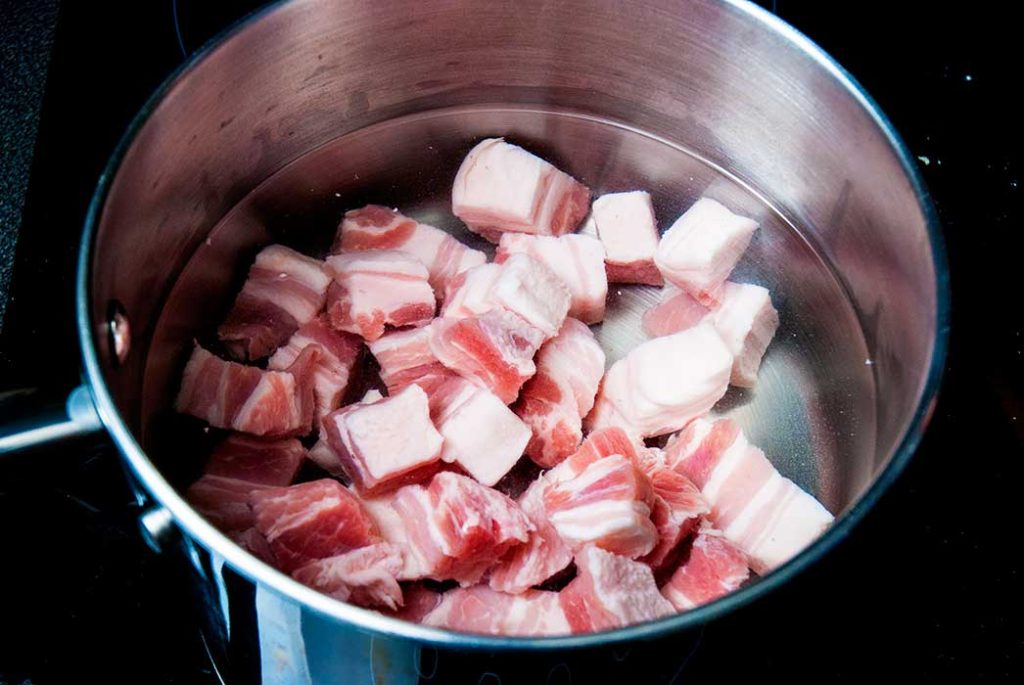
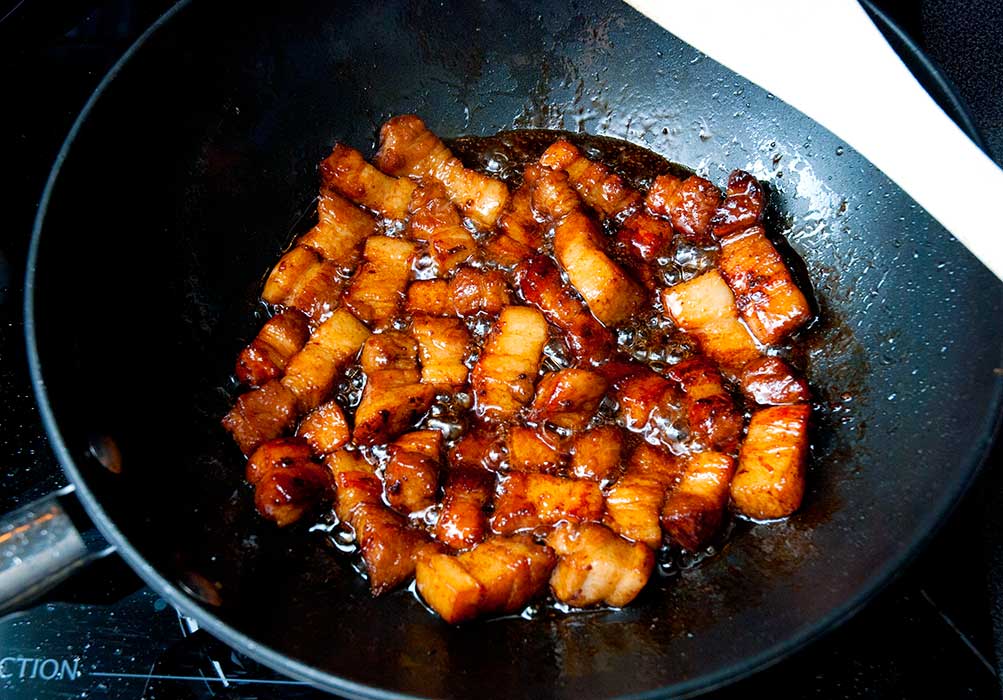
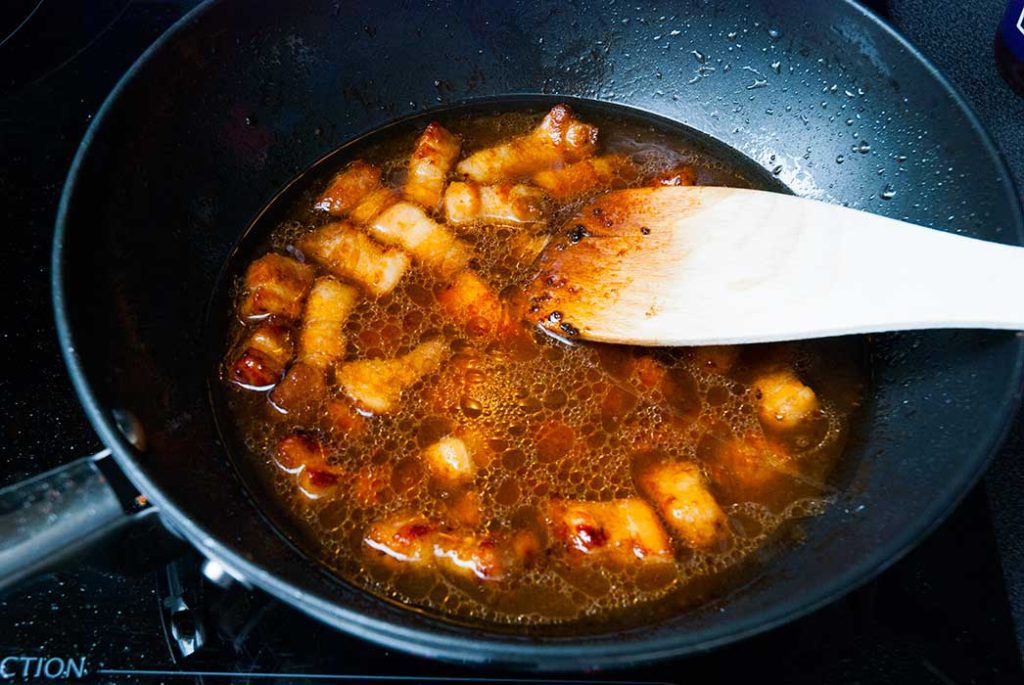
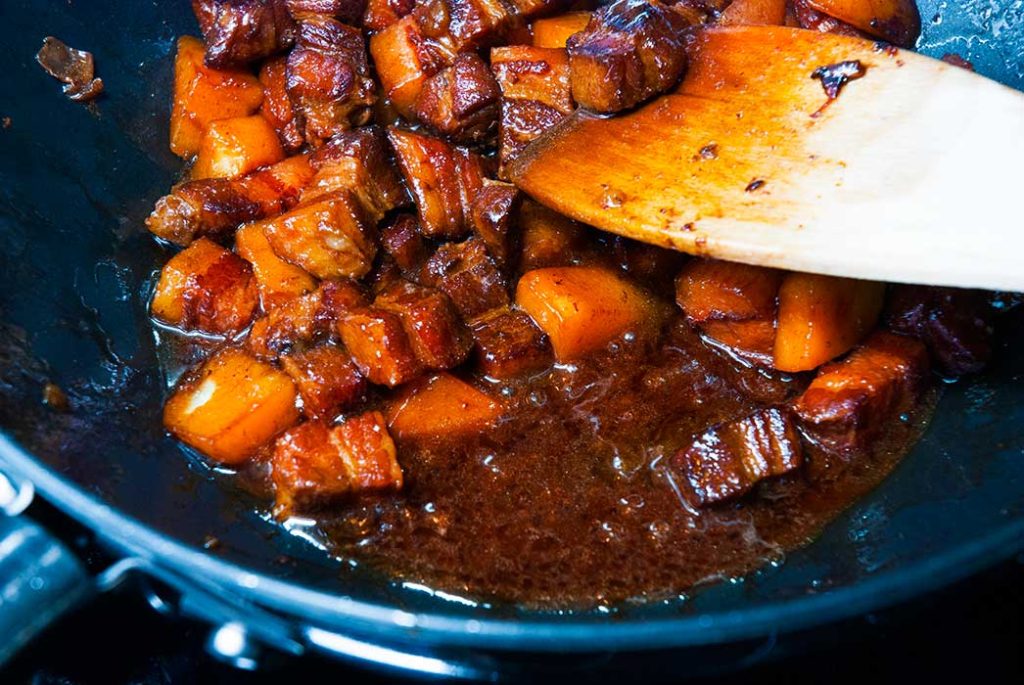
What to serve with Chinese Sweet Pork Belly?
It is best accompanied by rice or noodles of your choice.
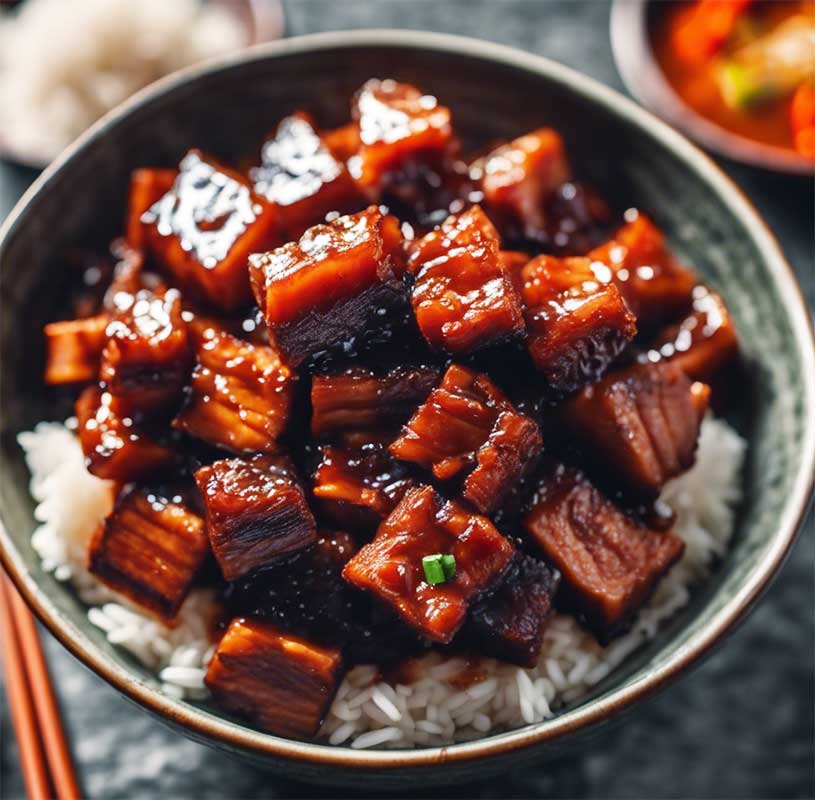
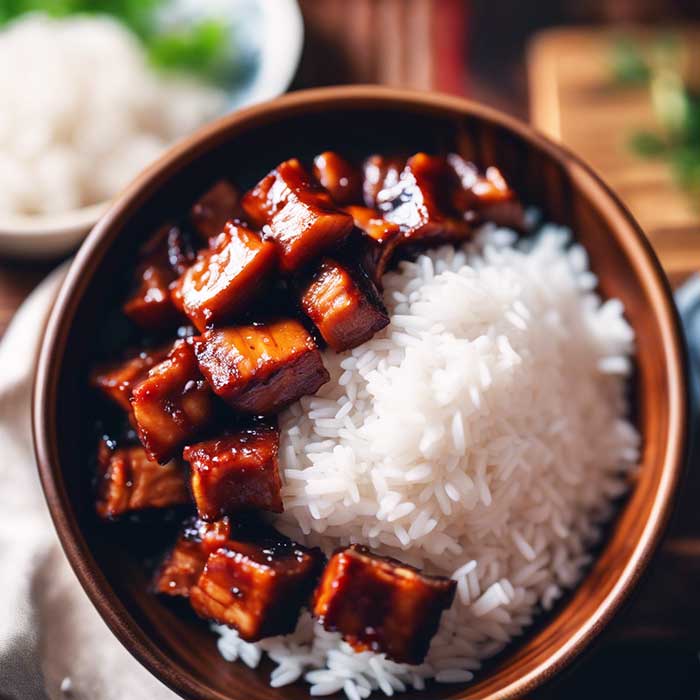
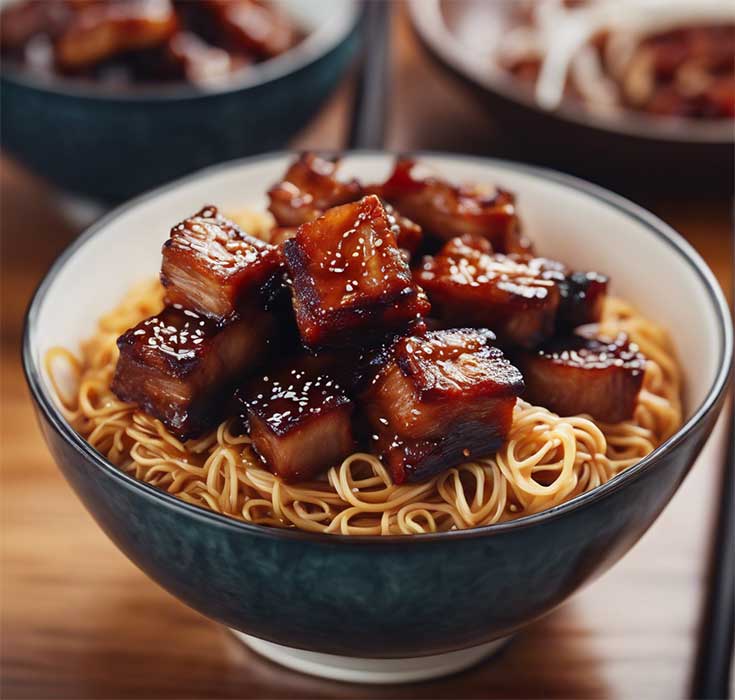
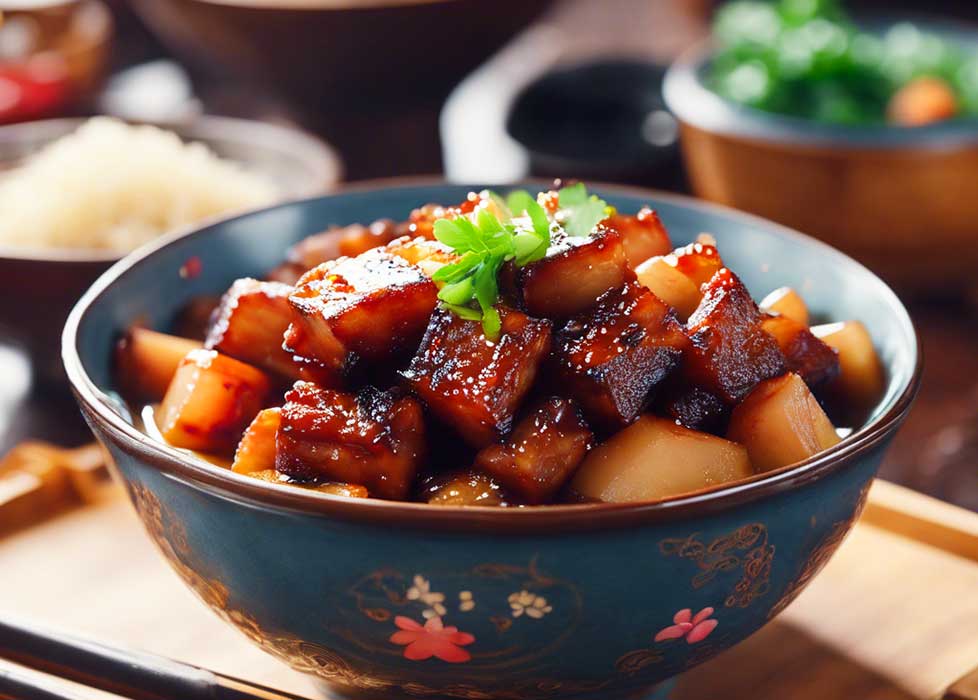
If prepared with potato, the meal becomes a satisfying dish on its own. For added flavour and texture, sprinkle sesame seeds on top or drizzle with sesame oil. Garnish with finely chopped spring onions.
Recipe Card
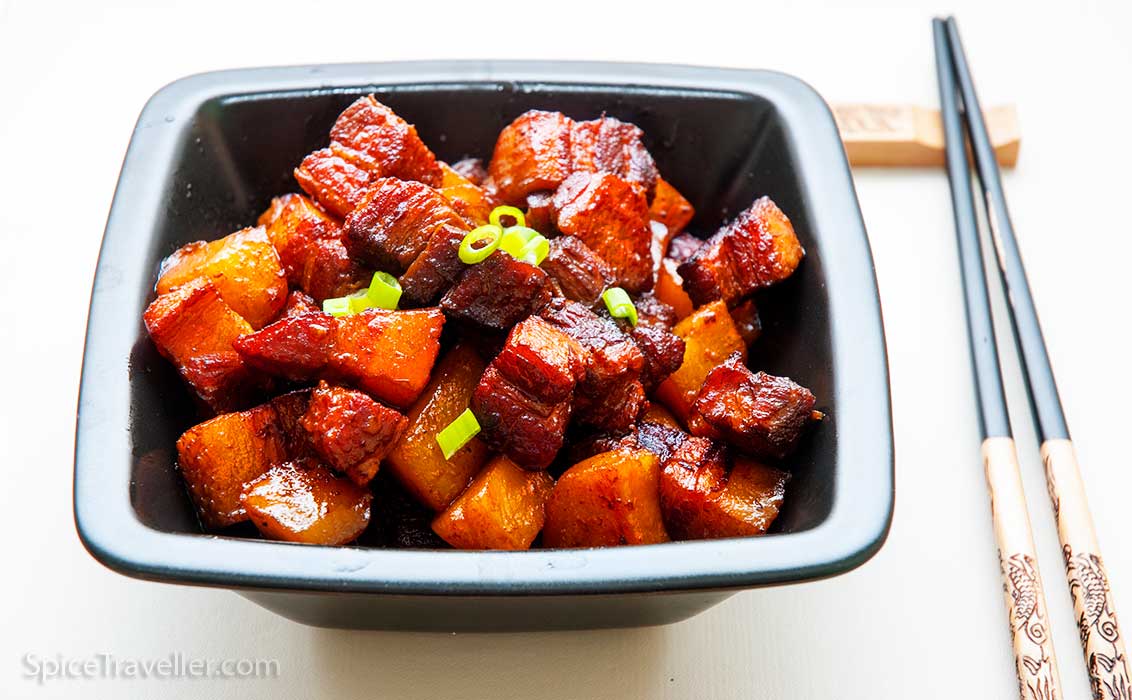
Chinese sweet and sticky pork belly Shanghai style
Ingredients
Blanching pork
- 3-4 spring onions
- 500 g pork belly
- 1 piece fresh ginger - 2-3 cm piece
- 4-5 cloves garlic
Caramelising pork
- 3 tbsp brown sugar
- 4 tbsp peanut oil
Cooking in sauce
- 5 tbsp Chinese rice wine - Shaoxing
- 2 tbsp dark soy sauce
- 4 tbsp light soy sauce
- 1 potato - large
- 1 ginger - small piece, finely chopped
- 2-3 cloves garlic
- 500-700 ml broth - from blanching
Instructions
- Cut the meat into approx 3cm cubes. Place it in cold water together with spring onion and garlic and cook for about 5 minutes. Skim off any foam or impurities that rise to the surface. Drain and set aside and pat dry with some kitchen towel.
- Heat oil in a wok on low – medium temperature and add sugar. When sugar melts, add the meat and stir-fry for about 1 minute on medium-high heat.
- Add broth or water, rice wine, soy sauce, ginger and garlic to the wok and simmer for about an hour, partially covered, leaving a small gap to allow some steam to escape. Add potatoes after 30 minutes of cooking. If needed, add more broth or water.
- After one hour, leave it uncovered, increase the heat to let the liquid evaporate, and thicken the sauce.
- When serving, garnish with finely chopped spring onions.
